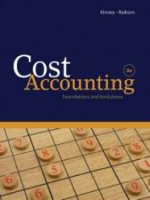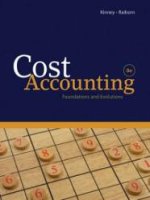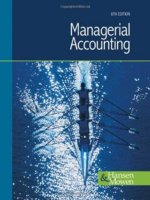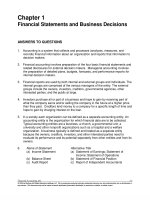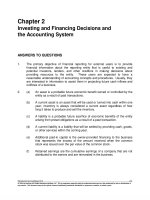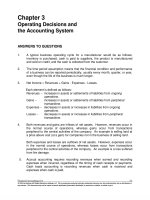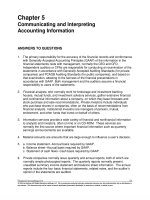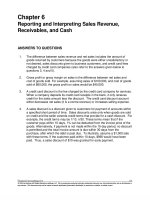Solution manual managerial accounting 8e by hansen mowen ch 13
Bạn đang xem bản rút gọn của tài liệu. Xem và tải ngay bản đầy đủ của tài liệu tại đây (276.36 KB, 48 trang )
To download more slides, ebook, solutions and test bank, visit
CHAPTER 13
CAPITAL INVESTMENT DECISIONS
QUESTIONS FOR WRITING AND DISCUSSION
1. Independent projects are such that the acceptance of one does not preclude the acceptance of another. With mutually exclusive
projects, acceptance of one precludes the
acceptance of others.
11.
If NPV > 0, then the investment is acceptable. If NPV < 0, then the investment should
be rejected.
12.
Disagree. Only if the funds received each
period from the investment are reinvested to
earn the IRR will the IRR be the actual rate
of return.
13.
Postaudits help managers determine if resources are being used wisely. Additional
resources or corrective action may be
needed. Postaudits also serve to encourage
managers to make good capital investment
decisions. They also provide feedback that
may help improve future decisions.
14.
NPV signals which investment maximizes
firm value; IRR may provide misleading signals. IRR may be popular because it provides the correct signal most of the time and
managers are accustomed to working with
rates of return.
15.
6. The accounting rate of return is the average
income divided by original or average investment. ARR = $100,000/$300,000 =
33.33%
Often, investments must be made in assets
that do not directly produce revenues. In this
case, choosing the asset with the least cost
(as measured by NPV) makes sense.
16.
7. Agree. Essentially, net present value is a
measure of the return in excess of the investment and its cost of capital.
NPV analysis is only as good as the accuracy of the cash flows. If projections of cash
flows are not accurate, then incorrect investment decisions may be made.
17.
The quality and reliability of the cash flow
projections are directly related to the assumptions and methods used for forecasting. If the assumptions and methods are
faulty, then the forecasts will be wrong, and
incorrect decisions may be made.
18.
The principal tax implications that should be
considered in Year 0 are gains and losses
on the sale of existing assets.
19.
The MACRS method provides more shielding effect in earlier years than the straightline method does. As a consequence, the
present value of the shielding benefit is
greater for the MACRS method.
2. The timing and quantity of cash flows determine the present value of a project. The
present value is critical for assessing whether a project is acceptable or not.
3. By ignoring the time value of money, good
projects can be rejected and bad projects
accepted.
4. The payback period is the time required to
recover the initial investment. Payback =
$80,000/$30,000 = 2.67 years
5. (a) A measure of risk. Roughly, projects with
shorter paybacks are less risky. (b) Obsolescence. If the risk of obsolescence is high,
firms will want to recover funds quickly. (c)
Self-interest. Managers want quick paybacks so that short-run performance measures are affected positively, enhancing
chances for bonuses and promotion. Also,
this method is easy to calculate.
8. NPV measures the increase in firm value
from a project.
9. The cost of capital is the cost of investment
funds and is usually viewed as the weighted
average of the costs of funds from all
sources. It should serve as the discount rate
for calculating net present value or the
benchmark for IRR analysis.
10.
For NPV, the required rate of return is the
discount rate. For IRR, the required rate of
return is the benchmark against which the
IRR is compared to determine whether an
investment is acceptable or not.
425
To download more slides, ebook, solutions and test bank, visit
20.
21.
to maintain or increase market share are
examples of intangible benefits. Reduction
in support labor in such areas as scheduling
and stores are indirect benefits.
The half-year convention assumes that an
asset is in service for only a half year in the
year of acquisition. Thus, only half of the first
year’s depreciation can be claimed, regardless of the date on which use of the asset
actually began. It increases the length of
time depreciation is recognized by one year
over the indicated class life.
22.
Intangible and indirect benefits are of much
greater importance in the advanced manufacturing environment. Greater quality, more
reliability, improved delivery, and the ability
426
Sensitivity analysis changes the assumptions on which the capital investment analysis is based. Even with sound assumptions,
there is still the element of uncertainty. No
one can predict the future with certainty. By
changing the assumptions, managers can
gain insight into the effects of uncertain future events.
To download more slides, ebook, solutions and test bank, visit
EXERCISES
13–1
1.
2.
3.
4.
5.
6.
7.
8.
9.
10.
11.
12.
13.
14.
15.
16.
17.
18.
19.
20.
a
e
c
a
d
e
c
b
d
e
b
c
a
e
c
a
e
b
e
c
13–2
1.
Payback period = $200,000/$60,000 = 3.33 years
2.
Payback period:
$125,000 1.0 year
175,000 1.0 year
200,000 0.8 year
$500,000 2.8 years
3. Investment = annual cash flow × payback period
= $120,000 × 3
= $360,000
4. Annual cash flow = Investment/payback period
= $250,000/2.5
= $100,000 per year
427
To download more slides, ebook, solutions and test bank, visit
13–3
1.
Initial investment (Average depreciation = 300,000):
Accounting rate of return = Average accounting income/Investment
= ($2,500,000 – $2,000,000 - $300,000)/$1,500,000
= 13.3%
2. Accounting rate of return (ARR):
Project A: ARR = ($12,800 – $4,000)/$20,000 = 44%
Project B: ARR = ($7,600 – $2,000)/$20,000 = 18%
Project A should be chosen.
3. ARR = Average Net Income/Average Investment
0.25 = $100,000/Average Investment
Average Investment = $100,000/0.25
= $400,000
Thus, Investment = 2 × $400,000
= $800,000
4. ARR = Average Net Income/Investment
0.50 = Average Net Income/$200,000
Average Net Income = 0.50 × $200,000
= $100,000
13–4
1.
NPV = P – I
= (5.650 × $240,000) – $1,360,000
= $(4,000)
The system should not be purchased.
2. NPV = P – I
= (4.623 × $9,000) – $30,000 = $11,607
Yes, he should make the investment.
428
To download more slides, ebook, solutions and test bank, visit
3. NPV = P - I
I = P – NPV
I = 4.355 × $10,000 - $3,550
= $40,000
13–5
1.
P = CF(df) = I for the IRR, thus,
df = Investment/Annual cash flow
= $1,563,500/$500,000
= 3.127
For five years and a discount factor of 3.127, the IRR is 18%.
2. P = CF(df) = I for the IRR, thus,
df = $521,600/$100,000 = 5.216
For ten years, and a discount factor of 5.216, IRR = 14%
Yes, the investment should be made.
3. CF(df) = I for the IRR, thus,
CF = I/df = $2,400,000/4.001 =$599,850.
13-6
1.
Larson Blood Analysis Equipment:
Year
0
1
2
3
4
5
NPV
Cash Flow
$(200,000)
120,000
100,000
80,000
40,000
20,000
Discount Factor
1.000
0.893
0.797
0.712
0.636
0.567
429
Present Value
$(200,000)
107,160
79,700
56,960
25,440
11,340
$ 80,600
To download more slides, ebook, solutions and test bank, visit
13-6 Concluded
Lawton Blood Analysis Equipment:
Year
0
1
2
3
4
5
NPV
Cash Flow
$(200,000)
20,000
20,000
120,000
160,000
180,000
Discount Factor
1.000
0.893
0.797
0.712
0.636
0.567
Present Value
$(200,000)
17,860
15,940
85,440
101,760
102,060
$ 123,060
2. CF(df) – I = NPV
CF(3.605) - $200,000 = $123,060
(3.605)CF = $323,060
CF = $323,060/3.605
CF = $89,614 per year
Thus, the annual cash flow must exceed $89,614 to be selected.
13–7
1.
Payback period = Original investment/Annual cash inflow
= $800,000/($1,300,000 – $1,000,000)
= $800,000/$300,000
= 2.67 years
2.
a.
Initial investment (Average depreciation = 160,000):
Accounting rate of return = Average accounting income/Investment
= ($300,000 – $160,000)/$800,000
= 17.5%
430
To download more slides, ebook, solutions and test bank, visit
13-7 Concluded
3.
Year
0
1
2
3
4
5
NPV
4.
P = CF(df) = I for the IRR, thus,
Cash Flow
$(800,000)
300,000
300,000
300,000
300,000
300,000
Discount Factor
1.000
0.909
0.826
0.751
0.683
0.621
Present Value
$(800,000)
272,700
247,800
225,300
204,900
186,300
$ 337,000
df = Investment/Annual cash flow
= $800,000/$300,000
= 2.67
For five years and a discount factor of 2.67, the IRR is between 24 and
26%.
13-8
1.
Payback period:
Project A:
$ 3,000
4,000
3,000
$10,000
1.00 year
1.00 year
0.60 year
2.60 years
Project B:
$ 3,000
4,000
3,000
$10,000
1.00 year
1.00 year
0.50 year
2.50 years
Both projects have about the same payback so the most profitable
should be chosen (Project A).
431
To download more slides, ebook, solutions and test bank, visit
13-8
2.
Concluded
Accounting rate of return (ARR):
Project A: ARR = ($6,400 – $2,000)/$10,000 = 44%
Project B: ARR = ($3,800 – $2,000)/$10,000 = 18%
Project A should be chosen.
3.
P = 9.818 × $24,000 = $235,632
Wilma should take the annuity.
4.
NPV = P – I
= (4.623 × $6,000) – $20,000 = $7,738
Yes, he should make the investment.
5.
df = $130,400/$25,000 = 5.216
IRR = 14%
Yes, the investment should be made.
13–9
1.
a. Return of the original investment
b. Cost of capital ($200,000 × 10%)
c. Profit earned on the investment
($231,000 – $220,000)
$200,000
20,000
11,000
Present value of profit:
P = F × Discount factor
= $11,000 × 0.909
= $9,999
2.
Cash Flow
Year
0
$(200,000)
1
231,000
Net present value
Discount Factor
1.000
0.909
Present Value
$(200,000)
209,979
$
9,979
Net present value gives the present value of future profits (the slight difference is due to rounding error in the discount factor).
432
To download more slides, ebook, solutions and test bank, visit
13–10
1.
Bond cost = $6,000/$120,000 = 0.05
Cost of capital
2.
= 0.05(0.6) + 0.175(0.4)
= 0.03 + 0.07
= 0.10
Year
Cash Flow
0
$(200,000)
1
100,000
2
100,000
3
100,000
Net present value
Discount Factor
1.000
0.909
0.826
0.751
Present Value
$(200,000)
90,900
82,600
75,100
$ 48,600
It is not necessary to subtract the interest payments and the dividend payments because these are associated with the cost of capital and are included
in the firm’s cost of capital of 10 percent.
433
To download more slides, ebook, solutions and test bank, visit
13–11
1.
P = I = df × CF
2.914* × CF = $120,000
CF = $41,181
*From Exhibit 13B-2, 14 percent for four years
2.
For IRR (discount factors from Exhibit 13B-2):
I = df × CF
= 2.402 × CF (1)
For NPV:
NPV = df × CF – I
= 2.577 × CF – I (2)
Substituting equation (1) into equation (2):
NPV = (2.577 × CF) – (2.402 × CF)
$1,750 = 0.175 × CF
CF = $1,750/0.175
= $10,000 in savings each year
Substituting CF = $10,000 into equation (1):
I = 2.402 × $10,000
= $24,020 original investment
3.
For IRR:
I = df × CF
$60,096 = df × $12,000
df = $60,096/$12,000
= 5.008
From Exhibit 13B-2, 18 percent column, the year corresponding to df = 5.008
is 14. Thus, the lathe must last 14 years.
434
To download more slides, ebook, solutions and test bank, visit
13–11 Concluded
4.
X = Cash flow in Year 4
Investment = 2X
Year
0
1
2
3
4
NPV
Cash Flow
$
(2X)
10,000
12,000
15,000
X
Discount Factor
1.000
0.909
0.826
0.751
0.683
–2X + $9,090 + $9,912 + $11,265 + 0.683X
–1.317X + $30,267
–1.317X
X
Cash flow in Year 4 = X = $20,000
Cost of project = 2X = $40,000
435
= $3,927
= $3,927
= ($26,340)
= $20,000
Present Value
$
(2X)
9,090
9,912
11,265
0.683X
$ 3,927
To download more slides, ebook, solutions and test bank, visit
13–12
1.
NPV:
Project I
Year
0
1
2
NPV
Cash Flow
$(100,000)
—
134,560
Discount Factor
1.000
—
0.826
Present Value
$(100,000)
—
111,147
$ 11,147
Cash Flow
$(100,000)
63,857
63,857
Discount Factor
1.000
0.909
0.826
Present Value
$(100,000)
58,046
52,746
$ 10,792
Project II
Year
0
1
2
NPV
Project I should be chosen using NPV.
IRR:
Project I
I
$100,000
(1 + i)2
1+I
IRR
= df × CF
= $134,560/(1 + i)2
= $134,560/$100,000
= 1.3456
= 1.16
= 16%
Project II
df = I/CF
= $100,000/$63,857
= 1.566
From Exhibit 13B-2, IRR = 18 percent.
Project II should be chosen using IRR.
2.
NPV is an absolute profitability measure and reveals how much the value of
the firm will change for each project; IRR gives a measure of relative profitability. Thus, since NPV reveals the total wealth change attributable to each
project, it is preferred to the IRR measure.
436
To download more slides, ebook, solutions and test bank, visit
13–13
Project A:
CF = NI + Noncash expenses
= $54,000 + $45,000
= $99,000
Project B:
CF = –[(1 – t) × Cash expenses] + [t × Noncash expenses]
= –(0.6 × $90,000) + (0.4 × $15,000)
= –$48,000
13–14
1.
Year
1
2
3
4
NPV
Depreciation
$2,000
4,000
4,000
2,000
tNC
$ 800
1,600
1,600
800
df
0.893
0.797
0.712
0.636
Present Value
$ 714
1,275
1,139
509
$3,637
2.
Year
1
2
3
4
NPV
Depreciation
$4,000
5,334
1,777
889
tNC
$1,600
2,134
711
356
df
0.893
0.797
0.712
0.636
Present Value
$1,429
1,701
506
226
$3,862
3.
MACRS increases the present value of tax shielding by increasing the amount
of depreciation in the earlier years.
437
To download more slides, ebook, solutions and test bank, visit
13–15
Purchase (assumes MACRS depreciation):
Year
0
1
2
3
4
5
NPV
(1 – t)C
—
$(3,000)a
(3,000)
(3,000)
(3,000)
(3,000)
tNC
—
$2,400b
3,840c
2,304d
1,382e
1,382e
CF
$(30,000)
(600)
840
(696)
(1,618)
(1,618)
df
1.000
0.909
0.826
0.751
0.683
0.621
a
$5,000 × 0.6
$30,000 × 0.2 × 0.4
c
$30,000 × 0.32 × 0.4
d
$30,000 × 0.192 × 0.4
e
$30,000 × 0.1152 × 0.4
b
Lease:
Year
0
1–5
5
NPV
(1 – t)C
$(7,500)*
CF
$(1,000)
(7,500)
1,000
df
1.000
3.791
0.621
P
$ (1,000)
(28,433)
621
$ (28,812)
*$12,500 × 0.6
The car should be leased because leasing has a lower cost.
438
P
$(30,000)
(545)
694
(523)
(1,105)
(1,005)
$(32,484)
To download more slides, ebook, solutions and test bank, visit
13–16
1.
Standard equipment (Rate = 18%):
Year
0
1
2
3–10
NPV
Cash Flow
$(500,000)
300,000
200,000
100,000
df
1.000
0.847
0.718
2.928
Present Value
$(500,000)
254,100
143,600
292,800
$ 190,500
Cash Flow
$(2,000,000)
100,000
200,000
300,000
400,000
500,000
1,000,000
df
1.000
0.847
0.718
0.609
1.323
0.314
0.682
Present Value
$(2,000,000)
84,700
143,600
182,700
529,200
157,000
682,000
$ (220,800)
Standard equipment (Rate = 10%):
Year
Cash Flow
0
$(500,000)
1
300,000
2
200,000
3–10
100,000
NPV
df
1.000
0.909
0.826
4.409
Present Value
$(500,000)
272,700
165,200
440,900
$ 378,800
df
1.000
0.909
0.826
0.751
1.868
0.513
1.277
Present Value
$(2,000,000)
90,900
165,200
225,300
747,200
256,500
1,277,000
$ 762,100
CAM equipment (Rate = 18%):
Year
0
1
2
3
4–6
7
8–10
NPV
2.
CAM equipment (Rate = 10%):
Year
0
1
2
3
4–6
7
8–10
NPV
Cash Flow
$(2,000,000)
100,000
200,000
300,000
400,000
500,000
1,000,000
439
To download more slides, ebook, solutions and test bank, visit
13–16 Concluded
3.
Notice how the cash flows using a 10 percent rate in Years 8–10 are weighted
compared to the 18 percent rate. The difference in present value is significant.
Using an excessive discount rate works against those projects that promise
large cash flows later in their lives. The best course of action for a firm is to
use its cost of capital as the discount rate. Otherwise, some very attractive
and essential investments could be overlooked.
13–17
1.
Standard equipment (Rate = 14%):
Year
0
1
2
3–10
NPV
Cash Flow
$(500,000)
300,000
200,000
100,000
df
1.000
0.877
0.769
3.571
Present Value
$(500,000)
263,100
153,800
357,100
$ 274,000
df
1.000
0.877
0.769
0.675
1.567
0.400
0.929
Present Value
$(2,000,000)
87,700
153,800
202,500
626,800
200,000
929,000
$ 199,800
df
1.000
0.877
0.769
3.571
Present Value
$(500,000)
263,100
153,800
178,550
$ 95,450
CAM equipment (Rate = 14%):
Year
0
1
2
3
4–6
7
8–10
NPV
2.
Cash Flow
$(2,000,000)
100,000
200,000
300,000
400,000
500,000
1,000,000
Standard equipment (Rate = 14%):
Year
0
1
2
3–10
NPV
Cash Flow
$(500,000)
300,000
200,000
50,000
The decision reverses—the CAM system is now preferable. This reversal is
attributable to the intangible benefit of maintaining market share. To remain
competitive, managers must make good decisions, and this exercise emphasizes how intangible benefits can affect decisions.
440
To download more slides, ebook, solutions and test bank, visit
PROBLEMS
13–18
1.
Accounting rate of return.
• Merits: The ARR method is relatively simple to use and easy to understand.
It considers the profitability of the projects under consideration.
• Limitations: It ignores cash flows and the time value of money.
Internal rate of return.
• Merits: It considers the time value of money. It measures the true rate of return of the project and productivity of the capital invested. Furthermore,
managers are accustomed to working with rates of return.
• Limitations: It is stated as a percentage rather than a dollar amount. It assumes that cash flows are reinvested at the IRR of the project. It may not
select the project that maximizes firm value.
Net present value method.
• Merits: It considers the time value of money and the size of the investment.
It measures the true economic return of the project, the productivity of the
capital, and the change in wealth of the shareholders.
• Limitations: It does not calculate a project’s rate of return, and it assumes
that all the cash flows are reinvested at the required rate of return.
Payback method.
• Merits: It provides a measure of the liquidity and risk of a project.
• Limitations: It ignores the time value of money. It ignores cash flows
beyond the payback period and, thus, ignores the profitability of a project.
2.
Nathan Skousen and Jake Murray are basing their judgment on the results of
the net present value and internal rate of return calculations. These are both
considered better measures because they include cash flows, the time value
of money, and the project’s profitability. Project B is better than Project A for
both of these measures.
441
To download more slides, ebook, solutions and test bank, visit
13–18 Concluded
3.
At least three qualitative considerations that should generally be considered
in capital budgeting evaluations include:
• Quicker response to market changes and flexibility in production capacity.
• Strategic fit and long-term competitive improvement from the project, or
the negative impact to the company’s competitiveness or image if it does
not make the investment.
• Risks inherent in the project, business, or country for the investment.
13–19
1.
Schedule of cash flows:
Year
0
1–7
Item
Cash Flow
Equipment
Working capital
$(300,000)
(30,000)
Cost savings
Equipment operating costs
5
Overhaul
7
Salvage value
Recovery of working capital
$135,000
(60,000)
(30,000)
24,000
30,000
NPV:
Year
0
1–7
5
7
NPV
Cash Flow
$(330,000)
75,000
(30,000)
54,000
75,000
df
1.000
4.868
0.621
0.513
Present Value
$(330,000)
365,100
(18,630)
27,702
$ 44,172
Yes, the new process design should be accepted.
442
To download more slides, ebook, solutions and test bank, visit
13–20
1.
Schedule of cash flows:
Year
Item
Cash Flow
Equipment
Working capital
Total
$(1,100,000)
(50,000)
$(1,150,000)
1–5
Revenues
Operating expenses
Total
$ 1,500,000
(1,260,000)
$ 240,000
6
Revenues
Operating expenses
Major maintenance
Total
$ 1,500,000
(1,260,000)
(100,000)
$ 140,000
7–9
Revenues
Operating expenses
Total
$ 1,500,000
(1,260,000)
$ 240,000
10
Revenues
Operating expenses
Salvage
Recovery of working capital
Total
$ 1,500,000
(1,260,000)
40,000
50,000
$ 330,000
0
443
To download more slides, ebook, solutions and test bank, visit
13-20
2.
Concluded
Year
0
1–5
6
7
8
9
10
NPV
Cash Flow
$(1,150,000)
240,000
140,000
240,000
240,000
240,000
330,000
Discount Factor
1.000
3.605
0.507
0.452
0.404
0.361
0.322
Present Value
$(1,150,000)
865,200
70,980
108,480
96,960
86,640
106,260
$ 184,250
The product should be produced.
13-21
1.
df = Investment/Annual cash flow
= $96,660/$20,000
= 4.833
The IRR is 16 percent. The company should acquire the new system.
2.
Since I = P for the IRR:
I = df × CF
$96,660 = 6.145* × CF
6.145 × CF = $96,660
CF = $15,730
*Discount factor at 10 percent (cost of capital) for ten years
3.
For a life of eight years:
df = I/CF
= $96,660/$20,000
= 4.833
The IRR is between 12 percent and 14 percent—greater than the 10
percent cost of capital. The company should still acquire the new system.
444
To download more slides, ebook, solutions and test bank, visit
13-21
Concluded
Minimum cash flow at 10 percent for eight years:
I = df × CF
$96,660 = 5.335 × CF
5.335 × CF = $96,660
CF = $18,118
4.
Requirement 2 reveals that the estimates for cash savings can be off by
as much $4,270 (over 20 percent) without affecting the viability of the
new system. Requirement 3 reveals that the life of the new system can
be two years less than expected and the project is still viable. In the latter case, the cash flows can also decrease by almost ten percent as
well without changing the outcome. Thus, the sensitivity analysis
should strengthen the case for buying the new system.
13–22
1.
The IRR using the best estimates:
Selling price
Unit variable cost
Unit contribution margin
Per unit
$10
4
$ 6
Total contribution margin ($6 × 1,000,000 annual sales volume)
Less: Fixed costs
Annual cash flow
$ 6,000,000
2,000,000
$ 4,000,000
Discount factor = $12,000,000/$4,000,000 = 3.00
Five years and a discount factor of 3.00 implies a rate of approximately 20
percent.
2.
a. If the per-unit selling price is reduced 10 percent, the adjusted IRR is 8
percent, as calculated below:
Per unit
90% of selling price
$9
Unit variable cost
4
Contribution margin
$5
Total contribution margin ($5 × 1,000,000 annual sales volume) $5,000,000
Less: Fixed costs
2,000,000
Annual cash flow
$3,000,000
445
To download more slides, ebook, solutions and test bank, visit
13–22 Concluded
Discount factor = $12,000,000/$3,000,000 = 4.00, which implies an IRR that
is approximately 8 percent.
b. If the per-unit sales volume is reduced 10 percent, the adjusted IRR is 13
percent, as calculated below:
Per unit
Selling price
$10
Unit variable cost
4
Contribution margin
$ 6
Total contribution margin ($6 × 900,000 annual sales volume)
Less: Fixed costs
Annual cash flow
$5,400,000
2,000,000
$3,400,000
Discount factor = $12,000,000/$3,400,000 = 3.53, which implies an IRR that
is approximately 13 percent (IRR between 12 and 14 percent).
c. If the per-unit variable cost is reduced 10 percent, the adjusted IRR is 24
percent, as calculated below:
Per unit
Selling price
$10.00
Unit variable cost
3.60
Contribution margin
$ 6.40
Total contribution margin
($6.40 × 1,000,000 annual sales volume)
Less: Fixed costs
Annual cash flow
$6,400,000
2,000,000
$4,400,000
Discount factor = $12,000,000/$4,400,000 = 2.73, which implies an IRR that
is approximately 24 percent.
3.
Sensitivity analysis determines the impact that certain changes in assumptions have on IRR or NPV as appropriate. It helps management to identify key
variables and to know whether additional information is needed. It also helps
determine the volatility of the project. Sensitivity analysis is limited because it
provides no information about probability and uncertainty. The range of values possible with their probability of occurrence are important information. It
also ignores the fact that assumptions are dynamic and can interact with
each other.
446
To download more slides, ebook, solutions and test bank, visit
13–23
1.
First, calculate the expected cash flows:
Days of operation each year: 365 – 15 = 350
Revenue per day: $200 × 2 × 150 = $60,000
Annual revenue: $60,000 × 350 = $21,000,000
Annual cash flow = Revenues – Operating costs
= $21,000,000 – $2,500,000
= $18,500,000
NPV = P – I
= (6.623 × $18,500,000) – $100,000,000
= $122,525,500 – $100,000,000
= $22,525,500
Yes, the aircraft should be purchased.
2.
Revised cash flow = (0.80 × $21,000,000) – $2,500,000
= $14,300,000
NPV = P – I
= (6.623 × $14,300,000) – $100,000,000
= $(5,291,100)
No, the aircraft should not be purchased.
3.
NPV = (6.623)CF – $100,000,000 = 0
CF = $100,000,000/6.623
= $15,098,898
Annual revenue = $15,098,898 + $2,500,000
= $17,598,898
Daily revenue = $17,598,898/350
= $50,283
Seats to be sold = $50,283/$400
= 126 seats (each way)
Seating rate needed = 126/150 = 84%
447
To download more slides, ebook, solutions and test bank, visit
13–23 Concluded
4.
Seats to be sold = $50,283/$440 = 115 (rounded up)
Seating rate = 115/150 = 77%
This seating rate is less than the most likely and above the least likely rate of
70 percent. There is some risk, since it is possible that the actual rate could
be below 77 percent. However, the interval is 20 percent (70 percent to 90
percent), and the 77 percent rate is only 35 percent of the way into the interval, suggesting a high probability of a positive NPV.
13–24
1.
1.00 year
1.00 year
1.00 year
0.13 year*
3.13 years
$16,800
24,000
29,400
3,800
$74,000
*$3,800/$29,400
Note: Cash flow = Increased revenue less cash expenses of $3,000
2.
Accounting rate of return using original investment:
Average cash flow = ($16,800 + $24,000 + $29,400 + $29,400)/4
= $24,900
Average depreciation = ($74,000 – $6,000)/4 = $17,000
Accounting rate of return = ($24,900 – $17,000)/$74,000
= $7,900/$74,000
= 10.7%
Accounting rate of return using average investment:
Accounting rate of return = $7,900/$40,000*
= 19.8%
*Average investment = (Investment + Salvage)/2
= ($74,000 + $6,000)/2
448
To download more slides, ebook, solutions and test bank, visit
13–24 Concluded
3.
Year
0
1
2
3
4
NPV
Cash Flow
$(74,000)
16,800
24,000
29,400
35,400*
Discount Factor
1.000
0.893
0.797
0.712
0.636
Present Value
$(74,000)
15,002
19,128
20,933
22,514
$ 3,577
Discount Factor
1.000
0.877
0.769
0.675
0.592
Present Value
$(74,000)
14,734
18,456
19,845
20,957
$
(8)
*Includes $6,000 salvage value
IRR (by trial and error):
Using 14 percent as the first guess:
Cash Flow
Year
0
$(74,000)
1
16,800
2
24,000
3
29,400
4
35,400
NPV
The IRR is about 14 percent.
The equipment should be purchased. (The NPV is positive and the IRR is
larger than the cost of capital.) Dr. Avard should not be concerned about the
accounting rate of return in making this decision. The payback, however, may
be of some interest, particularly if cash flow is of concern to Dr. Avard.
4.
Year
0
1
2
3
4
NPV
Cash Flow
$(74,000)
11,200
16,000
19,600
25,600
Discount Factor
1.000
0.893
0.797
0.712
0.636
Present Value
$(74,000)
10,002
12,752
13,955
16,282
$(21,009)
For Years 1–4, the cash flows are 2/3 of the original cash flow increases. Year
4 also includes $6,000 salvage value.
Given the new information, Dr. Avard should not buy the equipment.
449
